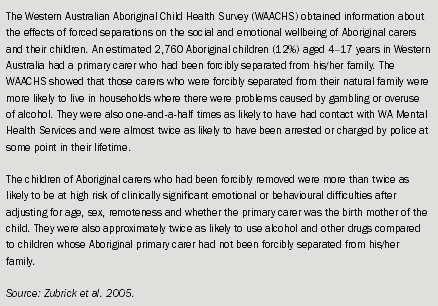In 1997, the Human Rights and Equal Opportunity Commission published Bringing them Home: Report of the National Inquiry into the Separation of Aboriginal and Torres Strait Islander Children from their Families. This report highlighted the very damaging effects that forced separation and institutionalisation have had, and continue to have, on Indigenous Australians. Evidence to the Inquiry clearly established that people who were separated from their families experience more health problems than those who were not separated. They suffer higher rates of emotional distress, depression, anxiety, heart disease and diabetes. There is also evidence to suggest that they are more likely to smoke (Ivers 2001) and to misuse alcohol and other substances. These problems are thought to be linked to the high levels of emotional distress and trauma surrounding removal from one's family, as well as early disruption in social and cultural attachment (HREOC 1997).
In 2002, around one in twelve (8%) of Indigenous Australians aged 15 years or over reported having been personally removed from their natural family. A further 29% reported having relatives who were removed from their family when they were children. The most frequently reported relatives removed were grandparents (15%), aunts or uncles (11%) and parents (9%).
Consistent with the findings of the Inquiry, the 2002 NATSISS showed that Indigenous people who were personally removed from their natural families reported poorer health outcomes. In comparison with those who were not removed from their families, those who had been taken away were more likely to report being in fair or poor health (40% compared with 22%) and were less likely to report being in excellent or very good health (33% compared with 46%). They were also more likely to regularly smoke cigarettes (65% compared with 47%) and to have a disability or long-term health condition (54% compared with 35%).
Removal was also associated with increased risk of mental health problems in 2002. The NATSISS did not explicitly identify persons in remote areas with a psychological disability. However in non-remote areas, rates of psychological disability were two and a half times higher among those who had been separated from their families compared with those who had not been separated (20% and 8% respectively).
8.10 Effects of forced separation on the social and emotional wellbeing of Aboriginal carers and their children

 Print Page
Print Page
 Print All
Print All